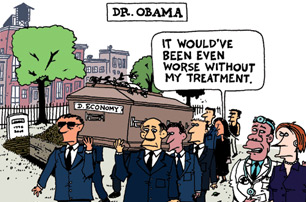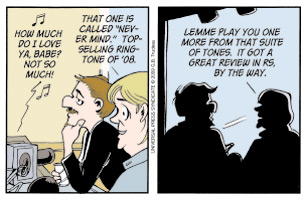
BroadbanditsWhat's wrong with the FCC's plan to bring high-speed Internet access to rural America.
Posted Tuesday, March 16, 2010, at 10:04 PM ETMost of the buildings in Dupree, S.D., population 434, do not have street addresses. The volunteer fire department is listed at P.O. Box 461, and you have to dial seven digits to reach it since there's no 911 emergency line. Unsurprisingly, the Greater Dupree Metropolitan Area also lacks broadband Internet service. "We're about 30 years behind the rest of the United States," says Mayor Don Howe. "In some ways, that's good. It's a slower pace of life."
Not for long—if the Federal Communications Commission has anything to say about it. On Tuesday morning, the FCC unleashed its 376-page plan for overhauling the nation's Internet connections, and it includes the goal of extending broadband access to the entire country. As part of the stimulus package, passed in early 2009, Congress ordered the FCC to come up with a plan to provide broadband service to regions with no access to it. According to the FCC, such regions are home to some 14 million people. (Another 79 million have access to it but can't afford it or don't want it.)
The plan, unveiled to a capacity crowd in an FCC hearing room, has been largely well-received. Who's against faster Internet service? (Even the normally mulish National Association of Broadcasters, who are nervous about losing their chunk of the spectrum, had tentative praise for it.) As FCC Commissioner Mignon Clyburn put it: "If we sit back and do nothing, we will be supporting the development of a long-lasting underclass of those who do not have access to the most basic needs." But supporting faster Internet service isn't the same as supporting a federal subsidy for faster Internet service.
A map of broadband availability by county closely resembles a population density map, and for good reason: In areas where a few people live far apart, it's simply not profitable to install the various lines and routers that deliver the Internet to consumers. The FCC estimates that it would cost $24 billion to subsidize a ground-based network to all 14 million of these unconnecteds. This figure is a bit misleading, however, because the complex model of broadband adoption that the FCC built to estimate these costs produces a classic power-law curve. Of that $24 billion, $10 billion would extended access to 96 percent of those without broadband access. That last 4 percent would cost $14 billion—about $56,000 per home.
The median family income in Dupree in 2000 was less than $21,000. Howe said he doubts many people would pay, say, $30 a month for high-speed Internet. Would they use it at a school or in a library? Possibly at school, he said. There is no library.
Before the federal government invests billions in extending high-speed Internet to such areas, it ought to make sure people want it—and are ready for it. A recent FCC survey by John Horrigan, who's been studying broadband adoption patterns for years, found that the 79 million who resist getting broadband do so for the usual reasons: It's too expensive, they're not comfortable with computers, they're fearful of risks like identity theft, and so forth. (Only 14 percent said they use the Internet just at work and don't need it at home.) As one might guess, adoption rates are lowest for older Americans, minorities, those with little education, and in rural areas.
This is part of the reason the FCC suggests outreach efforts that say, "Hey, look at all the cool stuff you can do on the Internet!"—it wants to encourage more holdouts to give broadband a try. There are also proposals to expand programs that currently subsidize telephone service for low-income and rural regions to include broadband Internet service. The argument, which makes sense, is that computer and online literacy are essential skills for the 21st century, so programs should focus on regions where the infrastructure is already in place and reach out to people who simply haven't taken advantage of it yet.
The model that the FCC used for its estimates of population and cost, which will be detailed in a forthcoming white paper, took into account the demographics of uncovered areas in order to predict the return on investment for building out the network. In regions where a significant number of people are likely to adopt broadband—that is, where it isn't too unprofitable to wire them up—a modest federal subsidy is a sensible solution. (The FCC claims its plan is budget neutral since it also proposes freeing up and auctioning off 500 megahertz of the spectrum.) But there is no company in America—at least no company that wanted to remain solvent—willing to pay scores of thousands of dollars per household to get broadband to the remotest parts of the country. It would probably be cheaper to buy each household its very own satellite connection.
A major focus of the FCC's broadband plan is on the development of 4G networks, which promise powerful wireless broadband to computers and mobile devices well beyond that which the increasingly ubiquitous 3G can provide. America's hard-to-reach areas are ideal testing grounds for the emerging technologies that promise to free us all from coaxial cables. Government officials and researchers should continue to study how best to introduce broadband access to underdeveloped regions. Doing so may require a blunt acknowledgement that providing broadband access is just part of encouraging digital literacy, and that investments should be prioritized to regions where the most people can benefit. No one wants to build the Fiber Optics Line to Nowhere.
Become a fan of Slate on Facebook. Follow us on Twitter.
on the Fray
-
French TV show reenacts Milgram experiment http://bit.ly/9veo1k
-
Christiane Amanpour set to replace George Stephanopoulos at This Week http://nyti.ms/9Xs2hq
-
130 House Republicans voted no on a resolution congratulating UMD basketball team http://bit.ly/cptiK5
 Spitzer: Only a Shareholder Revolution Can Fix Wall Street
Spitzer: Only a Shareholder Revolution Can Fix Wall Street I Want To Do Volunteer Work Abroad for My Vacation. Will It Do Any Good?
I Want To Do Volunteer Work Abroad for My Vacation. Will It Do Any Good? Shafer: The Most Bone-Headed Pharm-Party Article I've Ever Read
Shafer: The Most Bone-Headed Pharm-Party Article I've Ever Read Why Won't Insurance Companies Cover Fertility Treatments for Single Women?
Why Won't Insurance Companies Cover Fertility Treatments for Single Women? The Investment That Forces You To Root for the Demise of the United States
The Investment That Forces You To Root for the Demise of the United States Can the Pope Get Fired?
Can the Pope Get Fired?














